In 2015, Whole Foods partnered with the location-based marketing firm- Thinknear which helped them introduce geofencing marketing in their mobile strategy.
Here is what they did- whenever a Whole Foods user ended up in the close proximity of a Whole Foods store, he received a message that prompted him to visit the store. He would get the message even if he ended up in the proximity of a Whole Foods’ competitor.
The whole campaign gave them a post-click conversion rate of 4.69% which was “more than 3 times the industry average.”
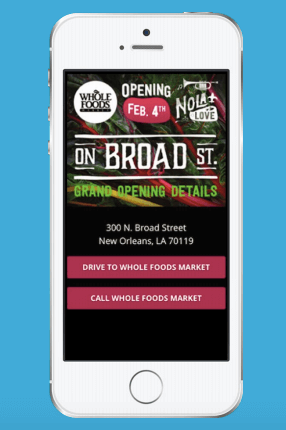
For a company like Whole Foods, even a fractional jump in such metrics imply millions in their bottom line.
We may not be Whole Foods, but you get the point, right?
Table of Contents:
- What is Geofencing?
- How Geofencing actually works?
- How to create Polygonal Geofences?
- How does location tracking work?
- The case with ‘enter’ and ‘exit’ conditions of Geofencing
- Mingling Geofencing with behavioural targeting
- Use-cases of Geofencing
- Advantages of Geofencing
- Geofencing usage examples
- A few note-worthy points regarding Geofencing
- Using Geofencing with WebEngage Journeys
Now, what is Geofencing?
Geofencing is a location-based service in which a creator of an app or other platform/software uses GPS, RFID, Wi-Fi or cellular data to send/trigger messages like SMS, Email or In-App notifications (pre-programmed action) when mobile devices that enter, exit, or remain parked in the geographical location.
You can select and mark off a geographical area from a map and set up a digital barrier around it. This ‘fenced-off’ area can now detect and communicate with mobile devices that breach its territory.
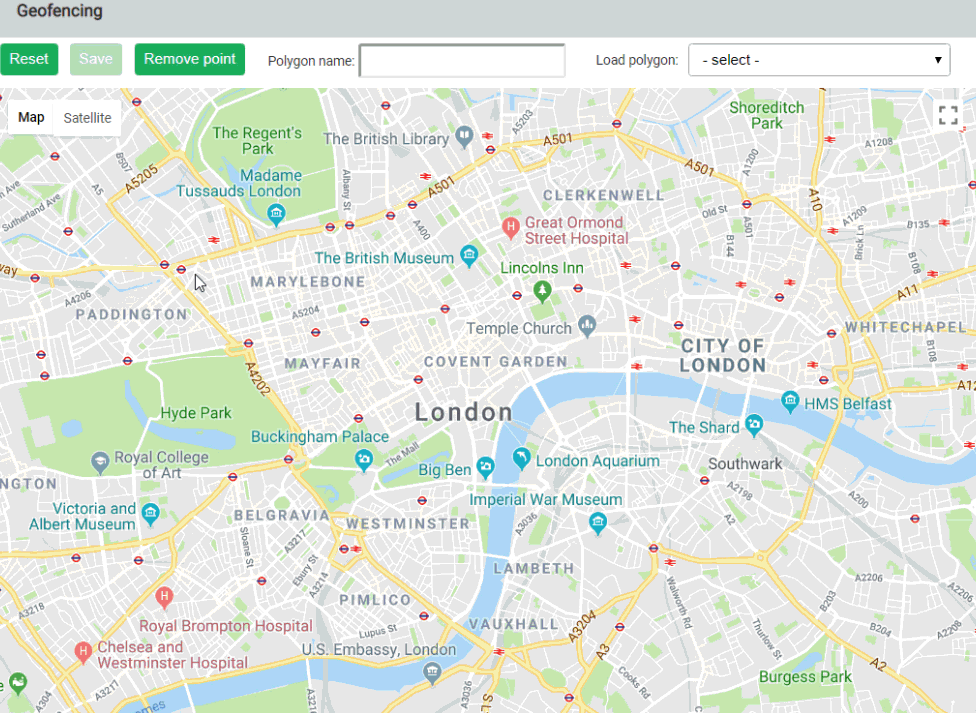
Although it has plenty of use-cases across industries but our marketing minds mostly associate it with proximity marketing, and this post is oriented around it.
Take a demo today with WebEngage and create That ‘Aha’ Experience For Your Customers!
Proximity marketing is a type of location-based marketing in which you send personalized communication to the user depending on how close he is to a particular location. This particularly helps offline retailers to have the same capability as their online counterparts in terms of providing contextual recommendations to users.
A Geofence gives its creator the ability to send messages via SMS, Email or App-based notifications to mobile devices that enter, exit, or remain parked in the marked area.
Remember this famous Starbucks message?

Users got it because they entered the geofence, built by Starbucks, around one of their physical stores.
Both Android and iOS allow you to create a geofence by specifying the radius and lat-long (short for latitude and longitude) of the centre of the real geographical region that you wish to monitor.

Being able to create such virtual boundaries have incredible use-cases for mobile publishers and consumer businesses.
Sending a real-time message when the user is in proximity is just one example. We shall learn about the underlying concept later that would enable you to think of such use-cases yourselves.
Now, to understand the nuance of how it works, let’s first get the technical aspects right.
How Geofencing actually works?
Geofence is built using Geofence.Builder class in Android. (For the sake of simplicity let’s only focus on Android for now.)
Take a look at the sample code below. No problem if you are not a code-lover, neither am I. Just throw a quick glance and the comments (text followed by //) would explain everything.
{
Geofence geofence = new Geofence.Builder()
.setRequestId(GEOFENCE_REQ_ID) // Geofence ID
.setCircularRegion( LATITUDE, LONGITUDE, RADIUS) // defining fence region
.setExpirationDuration( DURATION ) // expiring date
// Transition types that it should look for
.setTransitionTypes( Geofence.GEOFENCE_TRANSITION_ENTER | Geofence.GEOFENCE_TRANSITION_EXIT)
.build();
}
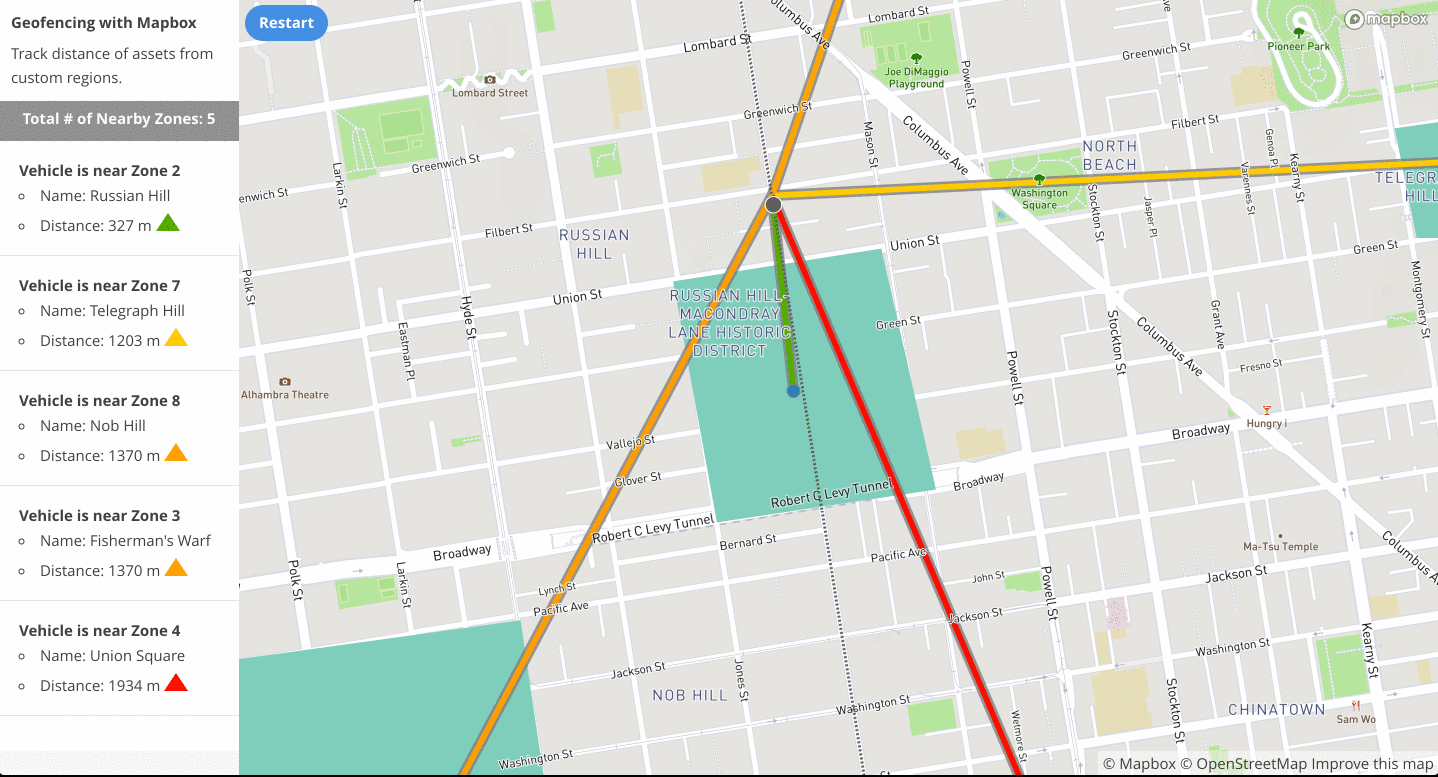
In the above GIF, there are two activities that take place:
- A mobile device enters the Geofence
- The device exits the Geofence
Once a geofence is activated, the system can trigger any action, as defined by you, when the user enters or exits. We will cover that in detail a little later.
All of the above-stated instances give a marketer three distinct avenues for user engagement powered by their location data and activity. Location-based marketing or Geofencing marketing gives brands the power to engage contextually concerning a user’s proximity to a precise physical location.
Also, as it is apparent from the above code, the function defining the boundary of the geofence [.setCircularRegion] accepts three arguments- Latitude, Longitude, Radius.
So, this makes geofences inherently circular in nature.
Now, when you are targeting a circular area or when accuracy is not so much the point of concern then it’s okay creating a circular geofence. But what if you are like Uber- as in, you wish to monitor a strictly non-circular area like arrival area of the airport to quote a different price or initiate a different promotion.
For such use-cases, you need polygonal geofences.
How to create Polygonal Geofences?

To create a polygonal geofence the standard procedure remains the same. It’s just that, later on, you simply run a check whether the current lat/long from the polygonal boundary is enclosed in the geofence or not.
There is a beautiful thread on stackoverflow that addresses the same question.
Now, Geofencing heavily depends on the location accuracy of the user’s device. How?
Suppose you are targeting at a city level. With such broad targeting accuracy is not the major concern. You could easily accept the error of up to 1000 meters.
However, if you are targeting users present less than 50 meters away from your business, like what Whole Foods did, then you require high accuracy. Accuracy, in turn, is the function of how precise your device’s location tracking is.
This brings us to our next question:
How does location tracking work?
Location tracking is the precursor to geofencing marketing and everything that has anything to do with geo-specific marketing.
To figure out the location, the apps use a location API to query the location coordinates both in Android and iOS environment. However, contrary to the popular perception, it’s not just GPS that could track user’s location. Location data can be/is fetched from different sources.
- Wifi
- Device Network
- Beacons
A combination of GPS, wifi and cell-tower triangulation is used to provide the most accurate Lat/Lon. There are other sources as well like IP, Beacon, etc but the above three are most common in use. To understand how triangulation works and how your Wifi router has anything to do with location tracking, refer to this article.
The app though, has to rely on the OS to get the geolocation data both in Android and iOS environments. App consumes the data, OS gets the location.
Android allows us to set the desired precision level of the location and it mentions the sources it would leverage to identify the location. (check image below) It is a good practice on Android’s part because GPS consumes excessive battery, way more than other sources of location tracking (network, wifi etc). This is the reason why apps like Runkeeper are renowned battery drainers.
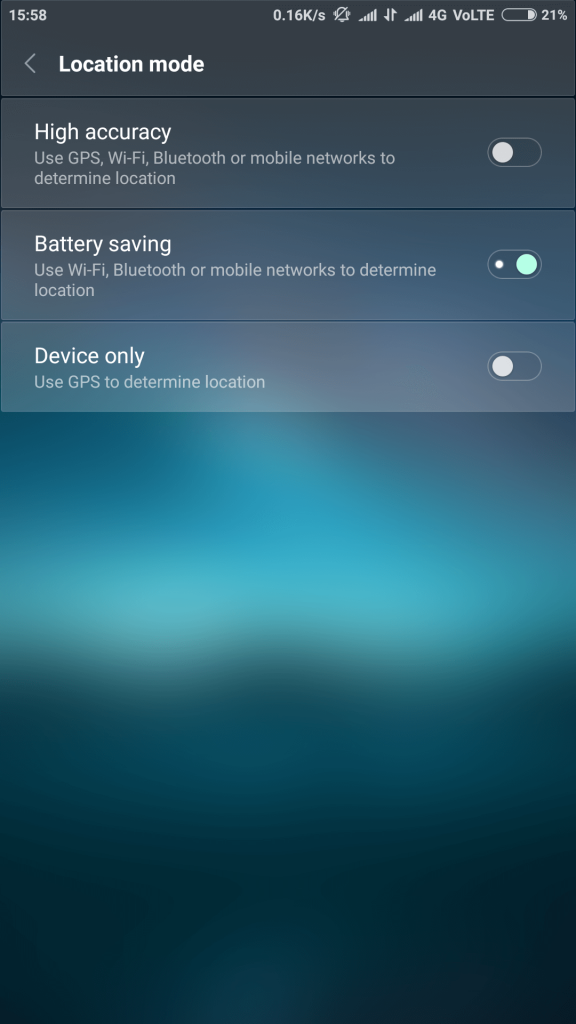
The OS’es currently require the apps to take explicit permission from the user to share his location (thankfully). Yet, Android has been accused of tracking users despite them having their location turned off. What if the user doesn’t give his permission?
Even if the user isn’t giving permission, the developer has the option to figure the location by using third-party services which rely on RIPE database to determine the location of the user. They basically track the IP address of the user to map it to the nearest cell tower. So they are not perfectly reliable but okay for city-level targeting.
Take a demo today with WebEngage and See Geofence Marketing in Action
The case with ‘enter’ and ‘exit’ conditions of Geofencing
Let’s consider a simple example. Suppose you create a geofence around your retail store. Once you do that, you can use ‘enter’ or ‘exit’ condition on this geofence as the trigger for any action.
Now there could be two types of behaviour segmentation here:
- Enter- Trigger a notification if the user enters the geo-fence
- Exit- A notification if he exits the geofence
The above two conditions for trigger can make you think on a vast number of use-cases for your business.
Example:
vouchercloud ran a campaign which triggered a push notification like the one below when the user is within 200m of a participating store. It got them a CTR of 45% which is remarkably higher than the industry average or their own best.
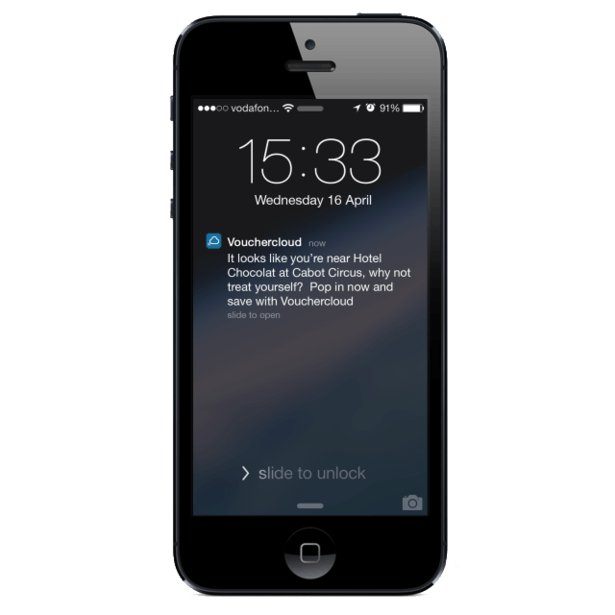
Mingling Geofencing with behavioural targeting
If we limit ourselves to ‘enter’ and ‘exit’ conditions as the trigger, then a typical use-case would be something as straightforward as the following:
– Trigger a push notification if the user enters the geofence say your retail store.
Now, how about mapping the geo-specific data of the user with his profile data.

The same campaign could be revamped as:
– Trigger a push notification if the user enters the geofence built around your store by nudging them with their last purchased category.
By creating a barrier on any geographical location you are basically recording the timestamp of entry and exit along with the location data.
So you might not be leveraging this data to push notifications to users in real time but the combination of entry, exit, and location data can help you in myriad ways to create value for users.
For instance, if we have data of the users who have visited Alaska more than thrice in a year then we would have some certainty that there are potential customers for Salmon fishing kit.
Likewise, there are infinite ways to engage users who have visited your area of interest. It can be beyond your competitor’s location, like a retail store, airport, Las Vegas etc.
So essentially, along with the user’s profile and behavioral data on app and web properties you are also considering the geolocation data to define engagement with your users. To do that you have to have a system which ingests the behavioral data of the users and simultaneously consumes the geolocation data of the user.
Use-Cases of Geofencing
-
-
Attracting more footfalls to a brick-and-mortar retail outlet
This is perhaps the most obvious use case that comes to mind. By creating a geofence around their physical retail locations, brands can target users who breach the Geofence with relevant messaging to get them into their stores.
-
Helping apps find their users better, faster for hyper-local servicing
Apps can use geofencing to track their users right down to their exact location actively and deliver products and services more effectively by optimizing their process delivery. A ride-hailing service like Uber uses geofencing to coordinate the process of assigning the closest, most accessible drivers to each pickup request by users.
(Do you know how to effectively measure the success of your mobile marketing efforts? We’ve a full-blown article on the best mobile app metrics. Check it out now!)
-
Driving up sales inside a retail outlet by directing traffic to specific sections
Retail outlets can use beacon technology to direct foot traffic to specific sections within the store. This is an exciting sales tactic that can help boost display impressions and conversions for particular product categories and support in-store activations and events by directing user traffic.
-
Regulation of public transport and other city-wide transit systems
Public transport apps can use geofencing to send general information alerts to users informing them about dynamic changes in the transit system, downtimes and special announcements when they are nearby a public transport hub.
Apps like Google Maps and Waze let users know of the best possible routes from their current location, toll payment for road users and also inform users about out of the ordinary situations like heavier than usual traffic jams, roadblocks, etc.
-
Optimizing logistics and warehousing
By aligning systems and processes based on geofences, a logistics hub can coordinate operations to work together by being alerted of the entry of workers and vehicles on the shop floor area and supply chain networks can be triggered to process shipments without any manual human intervention.
-
Improving functionality of home security and digital thermostat systems
IoT powered home security systems can inform users of a breach in a geofence, and open and shut doors, garage systems, and other amenities after recognizing known users within a geofence.
-
Social Networking
Social networking apps can use geofencing marketing to serve up highly personalized content, ads, and location-based tags and filters that are highly unique to that particular geographic location.
-
Improved Outdoor Event Management
The same Beacon technology can be leveraged at outdoor events and promotions as well, to keep track of users, understanding crowd movement patterns, managing crowds better, improve queue handling and push information to users who are in the proximity of your booth.
-
Getting feedback about the user’s experience after exiting a geofence
This one is pretty much self-explanatory. Brands can reach out to users who have exited a geofence bounding off their retail location to serve a feedback form and get more information about their recent experience.
-
Capturing leads at highly probable points of purchase
Travel apps and hotel aggregators can notify users about nearby hotels, lodging, and transport options at transit hubs like airports, railway stations, and bus stations to maximize the chances of last-minute purchases.
-
Targeting competitors’ retail locations to drive traffic to your site
This is an excellent ploy for retail businesses to try and capture a part of their competitors’ market share. Geofencing your competitor’s retail outlets can allow you to serve content & maybe competitive promotions about your brand to these users, and maximize your brand’s impression share and drive traffic to your business.
-
Take a demo today with WebEngage and Impact Visits & Sales By Reaching People Where They Are!
Advantages of Geofencing

Geofencing usage examples (by some of the biggest brands in the world)
Burger King vs. Mcdonald’s
QSR’s greatest rivalry took an interesting turn with location-based marketing. Burger King gave away burgers for next to free (1 cent) to users of their new mobile app on one condition: they had to go and unlock this offer at a Mcdonald’s restaurant (or within 600 ft. of an outlet), showing first-hand the efficacy of a relatively new location-based marketing tactic – Geo-conquesting!
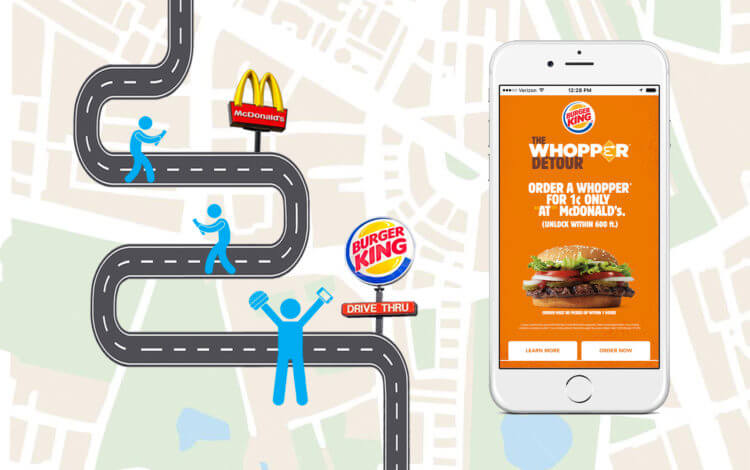
Take a demo today with WebEngage and create That ‘Aha’ Experience For Your Customers!
Dunkin Donuts: Snapchat Geofilter
On World Donut Day, Dunkin Donuts released a geo-filter on Snapchat that turns the user’s head into a giant Donut. The filter could only be unlocked at a Dunkin Donuts store, and it gave the user a free Donut with every coffee purchased.

Instagram Sticker via Geofencing for Indian elections
On account of the 2019 General election happening in India, Instagram introduced a location-specific sticker accessible via the ‘Stories’ feature. It featured a hand with blue ink on the index finger, an indication of casting one’s vote in the sub-continent.
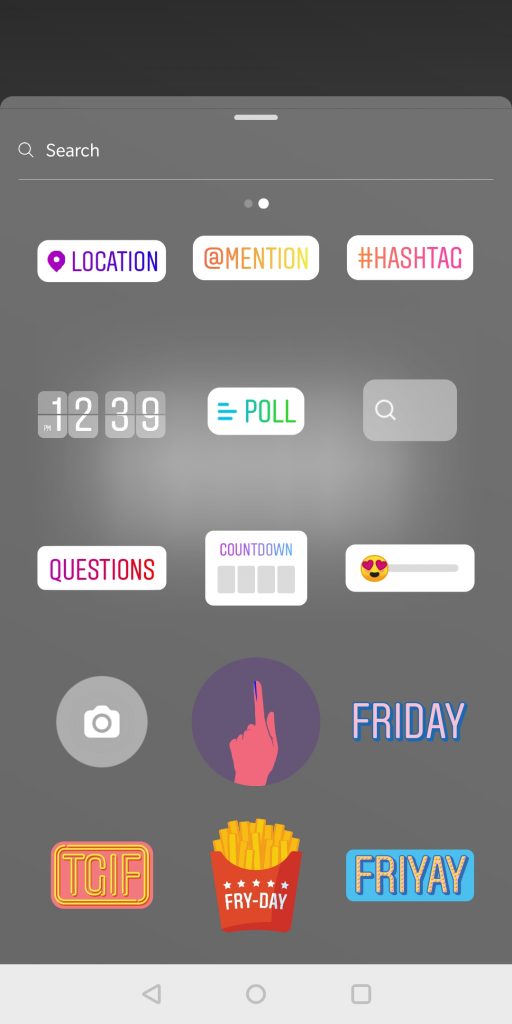
Hotel Tonight – Geofencing for hotel search
Online travel marketplace Hotel Tonight uses Geofencing to power its hotel search. They use cellular GPS data from users devices to pinpoint their exact locations. To deliver similar offerings for multiple users in the same vicinity, Hotel Tonight uses geofenced URL’s to group hotel room search results and offer a better experience to users and reduce their own processing load.
Also Read: Best Practices in User Engagement for Online Marketplaces
BMW Anti-theft IoT system
BMW uses Geofencing for their vehicles that come equipped with their BMW Trackstar and BMW Trackstar Advance services devices. Unauthorized car movement without car keys are triggers that notify the owners about such an event immediately in real-time.
American Eagle – Driving footfalls to physical outlets
Noted fashion retailer American Eagle effectively uses Geofencing marketing to drive users to their retail outlets. They tied up with shopping app Shopkick and used ‘Beacon tech’ to give users in-app coins by urging them to try products in the trial rooms. The campaign helped them triple sales in their retail stores.
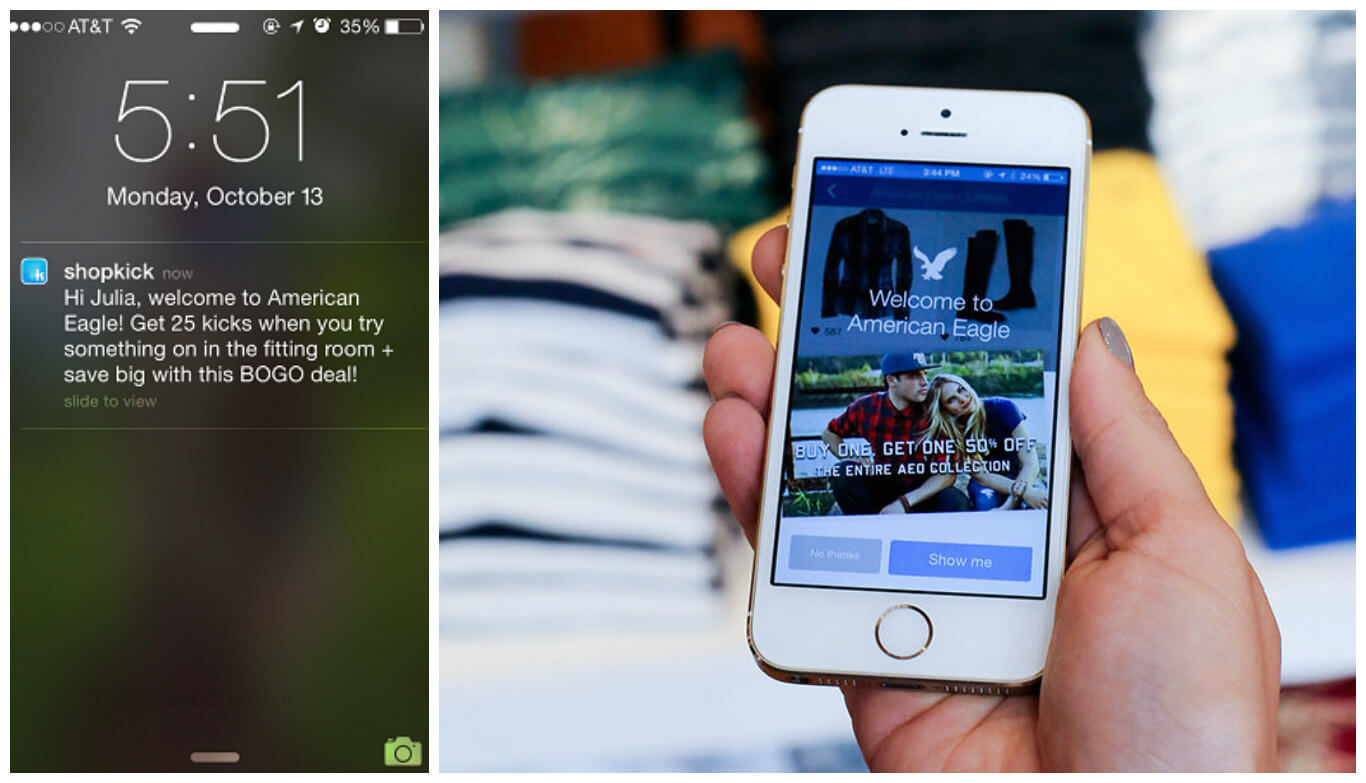
BFG movie promotion with Beacon tech
The BFG movie’s promoters, Entertainment One used Google’s Nearby feature to promote ‘Dream Jars‘ around London. They were live props referenced from the movie placed around strategic locations in London. Any Android user with Bluetooth switched on would get a push notification informing them about the presence of these dream jars.
![]()
Foursquare Geofencing
Foursquare detects new locations and serves related recommendations sourced from their user community to the user via push notifications. The idea is to utilize user-generated content contextually, and this is an excellent use-case for the brand.

Walgreens
Pharmacy giant Walgreens have taken rewards and loyalty to a whole new level with the use of geofencing. Deployed in-store beacons and doubled down on geofencing marketing to capture the attention of their app users and direct them to their rewards program status.
The idea was to highlight the current status of a user’s reward point balance, their reward money balance, and their reward milestone journey. It actively prompted users to spend their reward money balance, collect more reward points and progress further in their milestone journey.

Honorary mention – Companies are using geofence technology to find new hires- NBC News
A few note-worthy points regarding Geofencing

Using Geofencing with WebEngage Journeys
With WebEngage, marketers can leverage location-based marketing using Geofence trigger blocks in the Journey feature.
As you can see in the image below, you can create a Geofence trigger on a drag-and-drop interface. Create multiple geofences using the Google maps interface based on your requirements. You can also set a condition for the Geofence and assign a direct action for the trigger – send a push notification, SMS, or Email, however you wish to engage with the users.
All of this takes less than 5 mins and allows a marketer to use multi-channel marketing for their geofencing marketing campaigns. You can create highly complex workflows that trace the entire lifecycle of a user based on their activity, behavioral factors, or simple demographic factors.
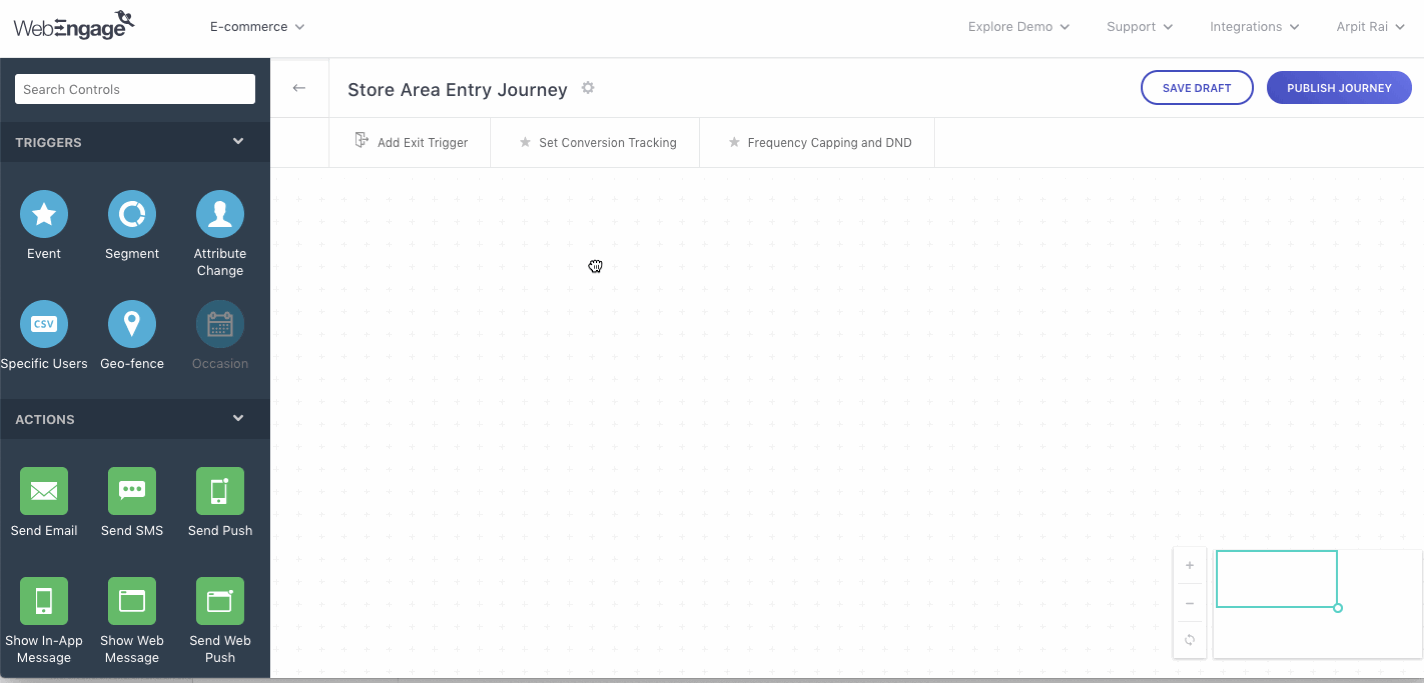
Take a demo today with WebEngage and Get Started With Geofencing Quickly
Conclusion
As per this report, geofencing market is pegged to reach $1.8 billion by 2022. Not surprisingly transportation and logistics form the major part of it. (Uber, Uber, Uber)
A certain district administration in India is planning to use geofencing to curb illegal mining. As in, if the sand is mined beyond the permissible limit then the authorities will be informed.
Proximity marketing has solid opportunities for consumer businesses particularly offline retailers. The only desire is the need to create value for users…..
And a powerful solution that lets you use this technology, like WebEngage (Sign-up for a quick chat)
Bonus Read – Boost Mobile Conversion Rates By As Much As 40%































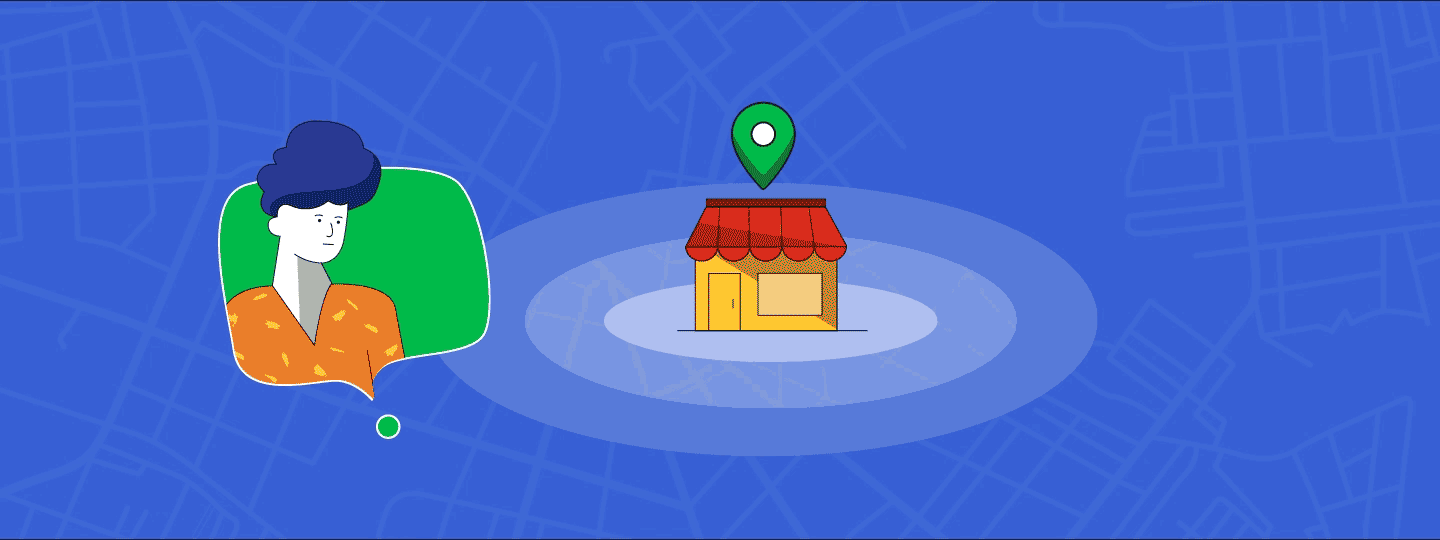


 Diksha Dwivedi
Diksha Dwivedi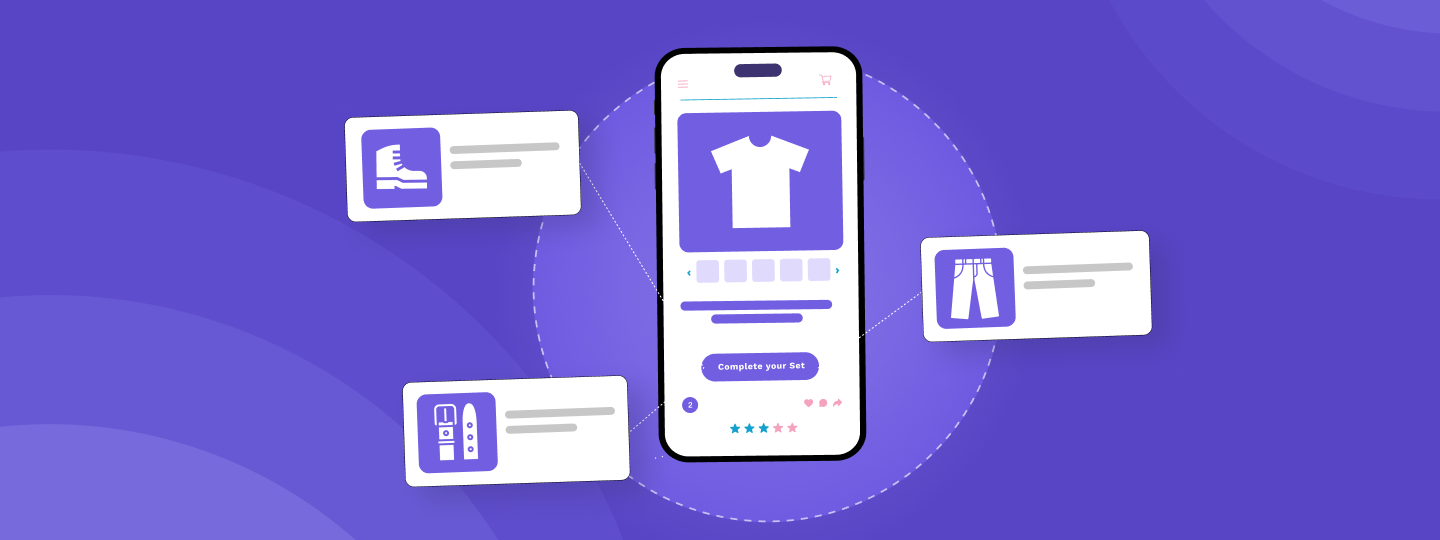
 Vanhishikha Bhargava
Vanhishikha Bhargava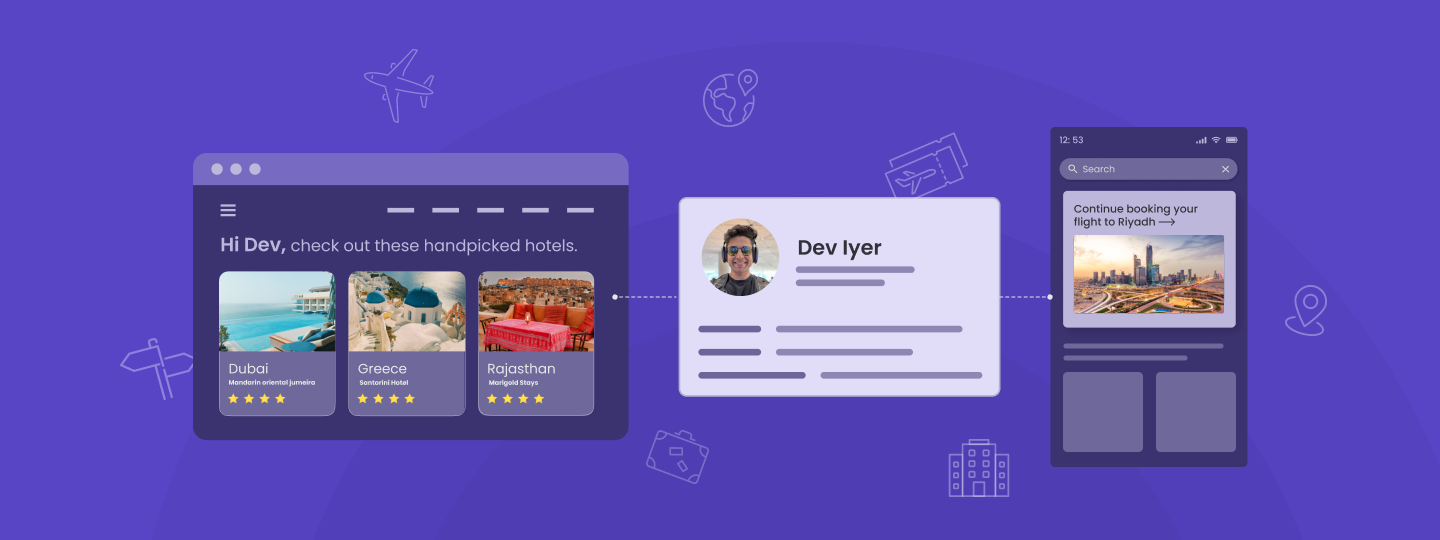
 Dev Iyer
Dev Iyer



